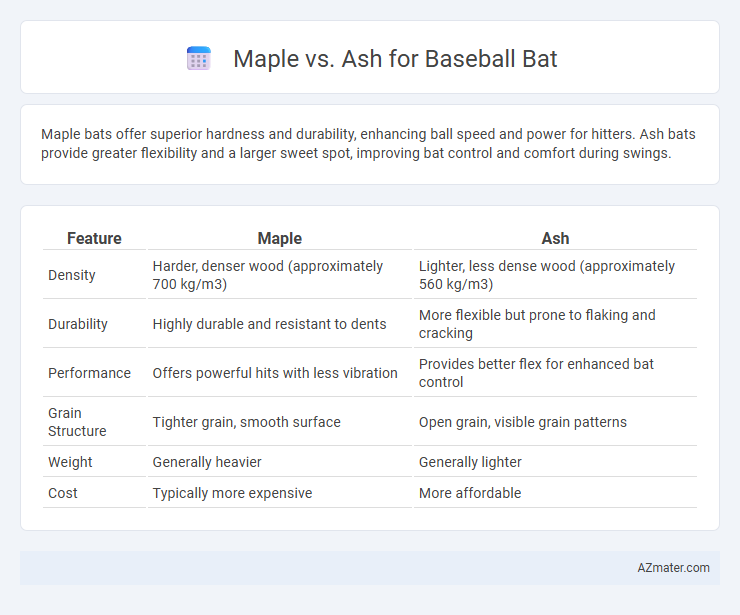Maple bats offer superior hardness and durability, enhancing ball speed and power for hitters. Ash bats provide greater flexibility and a larger sweet spot, improving bat control and comfort during swings.
Table of Comparison
| Feature | Maple | Ash |
|---|---|---|
| Density | Harder, denser wood (approximately 700 kg/m3) | Lighter, less dense wood (approximately 560 kg/m3) |
| Durability | Highly durable and resistant to dents | More flexible but prone to flaking and cracking |
| Performance | Offers powerful hits with less vibration | Provides better flex for enhanced bat control |
| Grain Structure | Tighter grain, smooth surface | Open grain, visible grain patterns |
| Weight | Generally heavier | Generally lighter |
| Cost | Typically more expensive | More affordable |
Introduction to Maple vs Ash Baseball Bats
Maple and ash are the two most popular woods used in baseball bats, each offering distinct advantages for players. Maple bats are denser and harder, providing increased power and durability, making them ideal for hitters seeking maximum impact. Ash bats are lighter with more flex, allowing for quicker swing speeds and better control, preferred by players who prioritize bat speed and feel.
Wood Characteristics: Maple and Ash Compared
Maple baseball bats are dense and hard, providing a stiff feel that delivers powerful hits with less vibration, ideal for players seeking maximum hitting power. Ash bats offer greater flexibility and a lighter weight, allowing faster swing speeds and better control, favored by players who prioritize bat speed and a balanced swing. The grain structure in maple is tighter and more uniform, enhancing durability, while ash's open grain allows it to flex more on impact, absorbing shock and reducing sting.
Durability and Lifespan of Maple vs Ash Bats
Maple baseball bats offer superior durability due to their dense, hard grain structure, which resists denting and cracking better than ash. Ash bats, while lighter and more flexible, tend to have a shorter lifespan because their more porous grain can splinter or wear down faster under repeated impacts. Players seeking long-lasting performance often prefer maple bats for their extended durability and consistent lifespan on the field.
Performance: Pop and Power Differences
Maple baseball bats deliver a harder surface and denser grain structure, generating greater pop and enhanced power on contact. Ash bats, known for their flexibility and lighter weight, offer increased whip action, enabling faster swing speeds but slightly less raw power. The denser maple wood compresses and rebounds ball energy more effectively, while ash's forgiving nature provides better control, influencing overall performance in power hitting.
Weight and Swing Speed Considerations
Maple baseball bats tend to be heavier than ash bats, which can impact swing speed and control; players seeking more power often prefer maple for its denser wood and ability to generate stronger hits. Ash bats are lighter and more flexible, allowing for faster swing speeds and better maneuverability, making them ideal for players who prioritize quickness and bat control. Choosing between maple and ash depends on balancing the need for weight-driven power and the advantage of increased swing speed.
Flexibility and Sweet Spot Analysis
Maple baseball bats offer a harder, denser wood structure, resulting in a smaller but more durable sweet spot, while ash bats have a more flexible grain that provides a larger sweet spot with enhanced whip for faster swing speeds. The flexibility of ash bats allows for greater vibration absorption and a more forgiving feel on off-center hits compared to the stiffer maple, which can transmit more shock to the hands. Players seeking a balance between power and control often prefer ash for its flexibility and expansive sweet spot, whereas those prioritizing hardness and longevity tend to favor maple.
Player Preferences: Pros and Cons
Maple baseball bats offer increased hardness and durability, favored by players seeking powerful hits and a solid feel, but they tend to be heavier and can be more prone to cracking under certain conditions. Ash bats provide greater flexibility and a lighter swing weight, making them ideal for players who prioritize bat speed and control, though they often lack the same hardness and may splinter over time. Player preferences hinge on balancing the need for power versus swing speed, with maple suited for power hitters and ash preferred by those valuing maneuverability and feedback.
Popularity Among Professional Players
Maple bats dominate the professional baseball scene due to their hardness and durability, favored by many MLB players for enhanced power and longevity. Ash bats remain popular among players who prefer a lighter and more flexible feel, offering better bat speed and control. The choice between maple and ash often depends on individual hitting style and performance preferences, with maple currently leading in popularity at the highest levels of professional play.
Cost Differences and Availability
Maple baseball bats generally come at a higher price point than ash bats due to the wood's density and durability, making them a preferred choice for serious players despite the cost. Ash bats are often more affordable and widely available, thanks to lighter sourcing and traditional production, appealing to beginner and budget-conscious athletes. Availability of maple bats can be limited in certain regions due to supply constraints, whereas ash bats are more consistently stocked across various sporting goods stores.
Choosing the Right Bat: Maple or Ash?
Maple baseball bats offer a denser grain structure, delivering increased hardness and durability, which translates to a harder hit and longer lifespan. Ash bats provide greater flexibility and a lighter swing weight, enhancing bat speed and control for players who prioritize precision. Choosing the right bat depends on whether you value the power and resilience of maple or the lightweight, responsive feel of ash for your hitting style.

Infographic: Maple vs Ash for Baseball Bat
 azmater.com
azmater.com